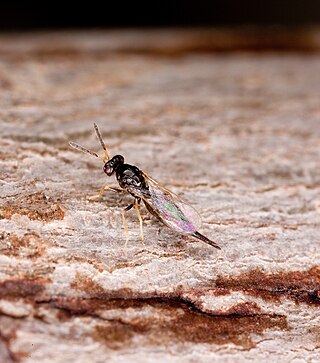
An ootheca is a type of egg capsule made by any member of a variety of species including mollusks, mantises, and cockroaches.

Casuarina, also known as she-oak, Australian pine and native pine, is a genus of flowering plants in the family Casuarinaceae, and is native to Australia, the Indian subcontinent, Southeast Asia, islands of the western Pacific Ocean, and eastern Africa.

The Eulophidae is a large family of hymenopteran insects, with over 4,300 described species in some 300 genera. The family includes the genus Elasmus, which used to be treated as a separate family, "Elasmidae", and is now treated as a subfamily of Eulophidae. These minute insects are challenging to study, as they deteriorate rapidly after death unless extreme care is taken, making identification of most museum specimens difficult. The larvae of very few species feed on plants, but the majority are primary parasitoids on a huge range of arthropods at all stages of development. They are exceptional in that they are one of two hymenopteran families with some species that are known to parasitize thrips. Eulophids are found throughout the world in virtually all habitats.
Kiggaella is a genus of hymenopteran insects belonging to the family Eulophidae. There is just one described species, Kiggaella oryzae, only known from rice paddies in Karnataka and Kerala states, India.
Aprostoporoides is a small Indomalayan genus of hymenopteran insects of the family Eulophidae which was described in 2004 with two newly described species from Kerala.
Aroplectrus is a genus of hymenopteran insects of the family Eulophidae.

Chrysocharis is a genus of hymenopteran insects of the family Eulophidae. Species in this genus are parasitoids as larvae, with hosts of multiple species being Agromyzidae flies.
Diglyphus is a genus of hymenopteran insects of the family Eulophidae. It is a parasitoid of Agromyzidae larvae, and therefore sometimes used in biological pest control.
Eprhopalotus is a genus of hymenopteran insects of the family Eulophidae. Their distribution varies between species but ranges from Costa Rica, Mexico to Texas. There are currently 5 species of Eprhopalotus:

Leptocybe invasa, the blue gum chalcid wasp or eucalyptus gall wasp, is a chalcid wasp which is the only species in the monotypic genus Leptocybe in the subfamily Tetrastichinae, of the family Eulophidae. It is a gall wasp which causes the formation of galls on a number of species of Eucalyptus, it was described in 2004 after galls were found in river red gums in the Mediterranean and Middle East and has since been found to be a widespread species where its host trees are planted. It is indigenous to Australia.
Omphalentedon is a genus of hymenopteran insects of the family Eulophidae.

Pediobius is a genus of hymenopteran insects of the chalcid wasp family Eulophidae. Like their relatives, the larvae of these diminutive wasps are parasitoids of various arthropods. Some Pediobius are used in biological pest control.

Ophelimus maskelli is a species of chalcid wasp about 1mm long, known as the eucalyptus gall wasp, indigenous to Australia and New Zealand, and invasive in the Mediterranean, the Middle East, North Africa, South Africa, tropical Asia, and the United States (California). It is considered a plant pest as females lay eggs on immature eucalyptus leaves; the larvae produce galls on the leaves. Heavy infestations induce much galling which causes widespread defoliation and loss of growth. Wasps may emerge in large numbers in the spring, forming clouds which are a nuisance to humans.

Quadrastichus erythrinae Kim, 2004, is a small parasitoid wasp belonging to the family Eulophidae, but also a secondary phytophage by way of inducing galls on the leaves, stems, petioles and young shoots of various Erythrina species.
Neotrichoporoides beyarslani is a species of wasp in the Eulophidae Family, is native to Turkey. The scientific name of this species was first published by Doganlar in 1993.

Tetrastichinae is a subfamily of the chalcid wasp family Eulophidae. It is one of the largest subfamilies of the Eulophidae containing over 100 genera and nearly 3,000 species. The species of the family Tetrastichinae are found in almost any type of terrestrial habitat and have a worldwide distribution, except Antarctica. They show a varied biology and hosts for Tetrastichinae wasps have been identified from over 100 different insect families, across 10 different orders and they have also been recorded as being parasitoids on nematodes, mites and spiders' eggs. Some species are even phytophagous, while others are inquilines and yet others are gall formers.
Entiinae is a subfamily of the chalcid wasp family Eulophidae. It was formerly better known as the Euderinae but this name was determined to be a junior homonym. It consists of 18 genera.
Hakuna is a genus of chalcid wasps from the family Eulophidae, containing the only species Hakuna matata. It was named in 2006 from specimens reared from a plant gall collected in a forest in Uganda. H. matata was named after a catchphrase from Disney's 1994 animated film The Lion King (the phrase itself comes from the Swahili phrase Hakuna matata. It was thought that this naming would best convey "an African spirit".
Oomyzus gallerucae is a species of chalcid wasp in the family Eulophidae. It is a parasitoid of the elm leaf beetle. The adults and larvae eat the eggs of the beetle.









